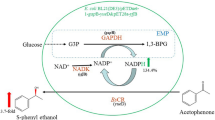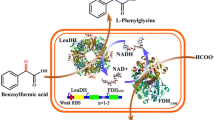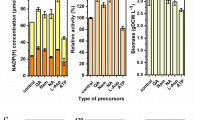Abstract
P450 BM3 mutant can catalyze indole to indoxyl, and indoxyl can dimerize to form indigo. But the reaction catalyzed by P450 BM3 requires NADPH, as coenzyme regeneration is very important in this system. As we know, when glucose dehydrogenase oxidizes glucose to glucolactone, NADH or NADPH can be formed, which can contribute to NADPH regeneration in the reaction catalyzed by P450 BM3. In this paper, a recombinant Escherichia coli BL21 (pET28a (+)-P450 BM3-gdh0310) was constructed to co-express both P450 BM3 gene and glucose dehydrogenase (GDH) gene. To improve the expression level of P450 BM3 and GDH in E. coli and to avoid the complex and low-efficiency refolding operation in the purification procedure, the expression conditions were optimized. Under the optimized conditions, the maximum P450 BM3 and GDH activities amounted to 8173.13 and 0.045 U/mg protein, respectively. Then bioconversion of indole to indigo was carried out by adding indole and glucose to the culture after improved expression level was obtained under optimized conditions, and 2.9 mM (760.6 mg/L) indigo was formed with an initial indole concentration of 5 mM.









Similar content being viewed by others
References
Alemayehu D, Gordon LM, O’Mahony MM, O’Leary ND, Dobson ADW (2004) Cloning and functional analysis by gene disruption of a novel gene involved in indigo production and luoranthene metabolism in Pseudomonas alcaligenes PA-10. FEMS Microbiol Lett 239:285–293
Bhushan B, Samanta SK, Jain RK (2000) Indigo production by naphthalene-degrading bacteria. Lett Appl Mcrobiol 31:5–9
Boddupalli SS, Pramanik BC, Slaughter CA, Estabrook RW, Peterson JA (1992) Fatty acid monooxygenati on by P450B M-3: product identification and proposed mechanisms for the sequential hydroxylation reactions. Arch Biochem Biophys 292(1):20–28
Boonstra B, Rathbone DA, French CE, Walker EH, Bruce NC (2000) Cofactor regeneration by a soluble pyridine nucleotide transhydrogenase for biological production of hydromorphone. Appl Environ Microbiol 66:5161–5166
Bradford MM (1976) A rapid and sensitive method for the quantitation of microgram quantities of protein utilizing the principle of protein-dye binding. Anal Biochem 72:248–254
Choi HS, Kim JK, Cho EH, Kim YC, Kim JI, Kim SW (2003) A novel flavin-containing monooxygenase from Methylophaga sp. Strain SK1 and its indigo synthesis in Escherichia coli. Biochem Biophys Res Commun 306:930–936
Coon MJ (2003) Multiple oxidants and multiple mechanisms in cytochrome P450 catalysis. Biochem Biophys Res Commun 312:163–168
Endo T, Koizumi S (2001) Microbial conversion with cofactor regeneration using genetically engineered bacteria. Adv Synth Cat 343:521–526
Itoh N, Matsuda M, Mabuchi M, Dairi T, Wang J (2002) Chiral alcohol production by NADH-dependent phenylacetaldehyde reductase coupled with in situ regeneration of NADH. Eur J Biochem 269:2394–2402
Kataoka M, Yamamoto K, Kawabata H, Wada M, Kita K, Yanase H, Shimizu S (1999) Stereoselective reduction of ethyl 4-chloro-3-oxobutanoate by Escherichia coli transformant cells coexpressing the aldehyde reductase and glucose dehydrogenase genes. Appl Microbiol Biotechnol 51:486–490
Li HM, Mei LH, Urlacher V, Schmid RD (2005) Cytochrome P450 BM-3 mutants with improved catalytic properties hydroxylating indole to indigo by error-prone PCR (in Chinese). Prog Biochem Biophys 32:1–6
Li QS, Schwaneberg U, Fische P, Schmi RD (2000) Directed evolution of the fatty-acid hydroxylase P450 BM-3 into an indole-hydroxylating catalyst. Chem Eur J 6:1531–1536
Liu Y, Xu ZN, Jing KJ, Jiang XX, Lin JP, Wang F, Cen PL (2005) Asymmetric reduction of ethyl 4-chloro-3-oxobutanoate to ethyl (R)4-chloro-3-hydroxybutanoate with two co-existing, recombinant Escherichia coli strains. Biotechnol Lett 27:119–125
Mermod N, Harayama S, Timmis KN (1986) New route to bacterial production of indigo. Biotechnology 4:321–324
Murdock D, Ensley BD, Serdar C, Thalen M (1993) Construction of metabolic operons catalyzing the de novo synthesis of indigo in Escherichia coli. Biotechnology 11:381–386
Narih LO, Fulco AJ (1986) Characterization of a catalytically self-sufficient 119,000-Dalton cytochrome P-450 monooxygenase induced by barbiturates in Bacillus Megaterium. J Biol Chem 261:7160–7169
O’Connor KE, Dobson ADW, Hartmans S (1997) Indigo formation by microorganisms expressing styrene monooxygenase activity. Appl Environ Microbial 63:4287–4291
Ortiz de Montellano PR (1995) Cytochrome P450: Structure, mechanism, and biochemistry, second edn. Plenum, New York
Royoa JL, Moreno-Ruiza E, Cebollab A, Santero E (2005) Stable long-term indigo production by overexpression of dioxygenase genes using a chromosomal integrated cascade expression circuit. J Biotechnol 116:113–124
Sambrook J, Russell DW (2001) Molecular cloning: a laboratory manual, 3rd edn. Cold Spring Harbor, New York
Gillam EMJ, Notley LM, Cai H, Voss JJD, Guengerich FP (2000) Oxidation of indole by cytochrome p450 enzymes. Biochemistry 39:13817–13824
Ensley BD, Ratzkin BJ, Ossulund TD, Simon MJ, Wackett LP, Gibson DT (1983) Expression of naphthalene oxidation genes in Escherichia coli results in the biosynthesis of indigo. Science 22:167–169
Acknowledgments
This work was financially supported by the National Natural Science Foundation of China (No. 30570411). The authors wish to thank Prof. R. D. Schmid (Institute of Technical Biochemistry, University of Stuttgart, Germany) for help.
Author information
Authors and Affiliations
Corresponding author
Rights and permissions
About this article
Cite this article
Lu, Y., Mei, L. Co-expression of P450 BM3 and glucose dehydrogenase by recombinant Escherichia coli and its application in an NADPH-dependent indigo production system. J Ind Microbiol Biotechnol 34, 247–253 (2007). https://doi.org/10.1007/s10295-006-0193-1
Received:
Accepted:
Published:
Issue Date:
DOI: https://doi.org/10.1007/s10295-006-0193-1




